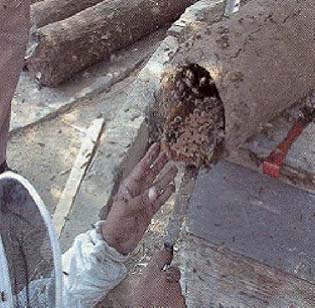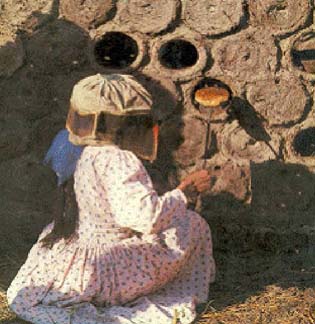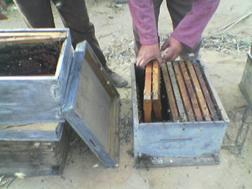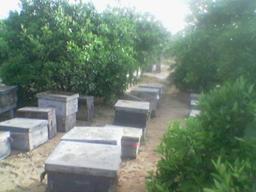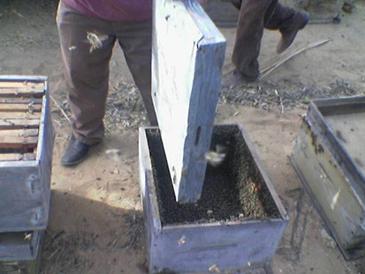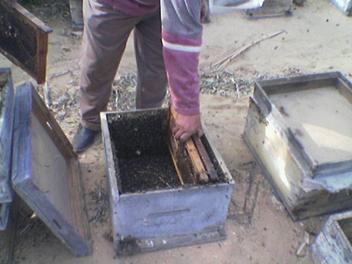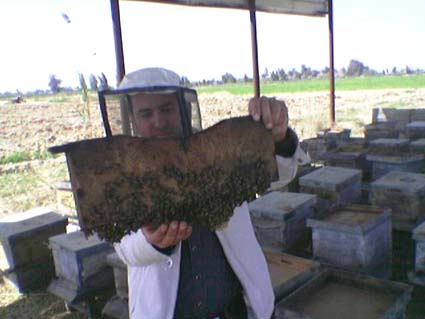Hossam Farag Abou-Shaara
Assistant lecturer at Faculty of Agriculture, Damanhour branch, Alexandria University, Egypt.
Member of the International Union for the Study of Social Insects (IUSSI)
North American Section (NAS) & Central European Section (CES)
Egyptian Beekeeping
part 2
Honey seasons:
Beekeeping seasons start from March up to November and winter season lasts from
December up to March. There are three main seasons in Egypt; Citrus season
during the first two weeks in April, Clover season from May up to the first week
of June, and Cotton season during August and September. The production per
colony is about 9 up to 15 Kg per year (all three pastures) and the total
production is 110000 Kg. Egypt exports honey to different countries. Also, Egypt
export beekeeping tools and swarms to different Arabian and African countries.
|
|
|
|
Honey collecting from tube hives |
A woman collects honey from tube hive |
|
|
|
|
Honey collecting from modern hives |
Apiary in citrus land |
Beekeeping practices:
In Egypt, there are no taxes on beekeeping sector, which helps a lot of people
establish apiaries in different places around Egypt. Subjectively, most
beekeepers in Egypt have not studied anything about insects or honeybees but
they keep bees by their own experience and practice. Beekeeping in Egypt is a
profession that passes from one generation to another. Most hives in Egypt
consist of one box only. Beekeepers prefer increasing the number of hives rather
than increasing the number of boxes in the same hive. All beekeepers in Egypt
deal with honeybee colonies without any protective clothes except the veil (face
protecting). Also, a lot of beekeepers do not use smokers during hives
inspection, in spite of the aggressiveness of colonies.
The number of queen producer in Egypt is very low. The Egyptian Ministry of
Agriculture has prevented the importation of queens since1960 to control
honeybee diseases. Egyptian beekeepers requeen every year by purchasing virgin
queens and let them to natural mating or by rearing virgins from the existing
colonies. Generally, studies in honeybee queens in Egypt are highly required.
Feeding of colonies depends mainly on sugar syrup. The colony feeds on about
0.5-1 Kg. per 14 days in nectar shortage periods. The winter in Egypt is not a
problem because the weather is very good around the year; not much water, no ice
and no heat. However, preparing the colonies to bear low temperature is
required. Most beekeepers use some pieces of clothes to keep the colonies warm
and extra frames are removed from the colonies during winter season. Inspection
of hives is done every week or every two weeks as the need arises.
Honey is collected at the last week of each season. Beekeepers extract honey
from all frames - remove all frames from the hive and cover it with the outer
cover in the morning and place the frames in the hives again in the evening,
after extracting the honey. In Egypt this is called full honey extracting.
The Egyptians do not like to consume much honey. The person in Egypt consume
about 0.5 up to 2 Kg. per year. The most of Egyptians consider honey as a
natural treatment only. Also, most of Egyptians do not like to consume food that
contains more sugar. Honey price is relatively high in Egypt - about 20-30
Egyptian Pounds. (3.3 - 5.0 $; 1 $ = 6 Egyptian pounds)
|
|
|
All frames of this hive have been removed to extract honey |
|
|
|
Beekeepers place frames into a hive after extracting honey |
|
|
|
Egyptian apiary and common wooden feeder held by the author of this article |
Honeybee races:
The common honeybee race in Egypt was Apis mellifera lamarckii, but now this
race does not exist in Egypt except for small districts in Upper Egypt, where it
is kept in modern and mud tube hives. The main reason for that is the
importation of large stocks of Apis mellifera carnica during about 30 years to
improve the characteristics of Egyptian honeybees. Also, different races have
been imported during a long period like Italian and German honeybees. As a
result of the importation of different races, the present honeybee in Egypt is a
hybrid between different races. This hybrid has it is own characteristics which
need more studies to be investigated. In general, most beekeepers prefer
Carniolan or Italian honeybees rather than any other race.
Diseases of honeybee:
The common diseases in Egypt are the same as in each place of the world.
However, Egyptian beekeepers pay more attention to varroa mites than to any
other disease. As I mentioned before, Egyptian beekeepers prefer to increase the
number of colonies in the apiary rather than increasing the number of boxes in
the same colony. As a result of that, beekeepers usually get rid of colonies
with AFB (American Foul Brood) or any other weak colonies.
Unfortunately, not many studies were done on Nosema, tracheal mite, viral or
bacterial diseases. On the contrary, a lot of studies were done on varroa mites.
In Egypt, there is not any specific treatment for Nosema or Fungal and viral
diseases. Antibiotics are common against Bacterial diseases and Amitraz is
common against varroa mites.
Common bee enemies:
In Egypt, Oriental red wasp Vespa orientalis and Wax moths are the common
enemies to honeybee colonies. Yellow wasps, bee lice, bee wolves and small hive
beetles are not problems in Egypt. Oriental red wasp appears from April and up
to the end of October while wax moths are found during the whole year. In
general, traps and reducing hive entrances are the common methods in controlling
wasps, while no specific method is used in controlling wax moths. Bee-eater is
also a seasonal enemy of Egyptian apiaries in spring and autumn.
Egypt, Spain and Greece:
Three countries are the oldest in beekeeping in all over the world; Egypt, Spain
and Greece. Nowadays, the number of honeybee colonies in Egypt is larger than
that in both Spain and Greece. Spain also has a larger number than that in
Greece. However, advanced researches and the improvements of beekeeping are used
in Spain and Greece and not in Egypt. I suggest that there was a common co
relationship between the native bees in these three countries. Unfortunately, no
cooperation was done between the three countries to investigate the relationship
between the native bees of these lands. Genetic and morphometric tools are
needed to investigate the common characters of the three native bees.
